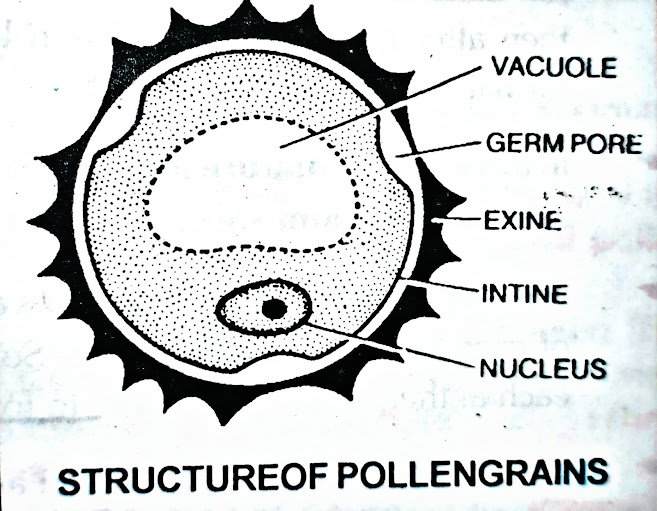STRUCTURE OF MICROSPORE OR POLLEN GRAIN :
pollen grain is the first cell of a male
gametophyte.
Pollen grain is termed as immature male gametophyte.
Usually, they are in round shape. Pollen grain surrounded by two distinct layers. The outer layer (wall) is thick, rigid and ornamented, called exine. This layer is formed by cutin and sporopollenin, Sporopollenin is highly resistent material.
It is nonbiodegradable.
Due to the presence of sporopollenin, fossils of pollen grain are always found in good condition. The presence of fossils of
STRUCTUREOF POLLENGRAINS
pollengrains can forecast the presence of natural resources like petroleum, coals etc. in the earth.
The internal layer is thin, soft and elastic in nature. It is called intine. It is made up of pectin and Cellulose or pecto-cellulose.
Usually, at few places on outer surface exine is absent or present in the form of thin layer. These thin places are called germ pore. The intine comes out through the any one germpore during the germination of pollen grain in the form of pollen tube.
The number of germpore, structure and ornamentation of exine is a significant feature of taxonomy.
A detail study of pollen grains is called Palynology.
Three colpus type (slit type) of germpore are present in pollen grain of most of the dicots (Capsella). This type of pollen grains are called tricolpate. Only one germ pore is present in monocots and pollen grain is called monocolpate.
The plants in which pollination takes place by insects, their pollen grains having oily layer around the pollen grain. It is called pollen-kitt. It is composed of lipids and carotenoids.
Function of pollen kitt :-
(i) This oily layer protects the pollen grain from the harmful ultraviolet rays.
(ii) Its sticky surface helps to attach with the insects.
Its yellow colour attracts the insects. Pollen kit is present on the pollens of Capsella.


Comments
Post a Comment